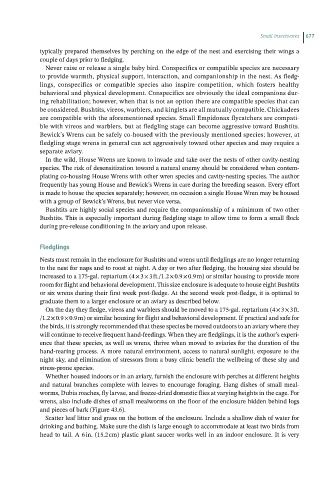Page 676 - Hand rearing birds second
P. 676
Small Insectivores 677
typically prepared themselves by perching on the edge of the nest and exercising their wings a
couple of days prior to fledging.
Never raise or release a single baby bird. Conspecifics or compatible species are necessary
to provide warmth, physical support, interaction, and companionship in the nest. As fledg -
lings, conspecifics or compatible species also inspire competition, which fosters healthy
behavioral and physical development. Conspecifics are obviously the ideal companions dur -
ing rehabilitation; however, when that is not an option there are compatible species that can
be considered. Bushtits, vireos, warblers, and kinglets are all mutually compatible. Chickadees
are compatible with the aforementioned species. Small Empidonax flycatchers are compati-
ble with vireos and warblers, but at fledgling stage can become aggressive toward Bushtits.
Bewick’s Wrens can be safely co‐housed with the previously mentioned species; however, at
fledgling stage wrens in general can act aggressively toward other species and may require a
separate aviary.
In the wild, House Wrens are known to invade and take over the nests of other cavity‐nesting
species. The risk of desensitization toward a natural enemy should be considered when contem-
plating co‐housing House Wrens with other wren species and cavity‐nesting species. The author
frequently has young House and Bewick’s Wrens in care during the breeding season. Every effort
is made to house the species separately; however, on occasion a single House Wren may be housed
with a group of Bewick’s Wrens, but never vice versa.
Bushtits are highly social species and require the companionship of a minimum of two other
Bushtits. This is especially important during fledgling stage to allow time to form a small flock
during pre‐release conditioning in the aviary and upon release.
Fledglings
Nests must remain in the enclosure for Bushtits and wrens until fledglings are no longer returning
to the nest for naps and to roost at night. A day or two after fledging, the housing size should be
increased to a 175‐gal. reptarium (4 × 3 × 3 ft./1.2 × 0.9 × 0.9 m) or similar housing to provide more
room for flight and behavioral development. This size enclosure is adequate to house eight Bushtits
or six wrens during their first week post‐fledge. At the second week post‐fledge, it is optimal to
graduate them to a larger enclosure or an aviary as described below.
On the day they fledge, vireos and warblers should be moved to a 175‐gal. reptarium (4 × 3 × 3 ft.
/1.2 × 0.9 × 0.9 m) or similar housing for flight and behavioral development. If practical and safe for
the birds, it is strongly recommended that these species be moved outdoors to an aviary where they
will continue to receive frequent hand‐feedings. When they are fledglings, it is the author’s experi-
ence that these species, as well as wrens, thrive when moved to aviaries for the duration of the
hand‐rearing process. A more natural environment, access to natural sunlight, exposure to the
night sky, and elimination of stressors from a busy clinic benefit the wellbeing of these shy and
stress‐prone species.
Whether housed indoors or in an aviary, furnish the enclosure with perches at different heights
and natural branches complete with leaves to encourage foraging. Hang dishes of small meal-
worms, Dubia roaches, fly larvae, and freeze‐dried domestic flies at varying heights in the cage. For
wrens, also include dishes of small mealworms on the floor of the enclosure hidden behind logs
and pieces of bark (Figure 43.6).
Scatter leaf litter and grass on the bottom of the enclosure. Include a shallow dish of water for
drinking and bathing. Make sure the dish is large enough to accommodate at least two birds from
head to tail. A 6 in. (15.2 cm) plastic plant saucer works well in an indoor enclosure. It is very

